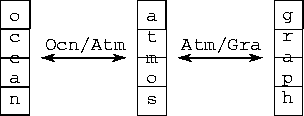![[DBPP]](pictures//asm_color_tiny.gif)





![[Search]](pictures//search_motif.gif)
Next: 8.9 Summary
Up: 8 Message Passing Interface
Previous: 8.7 Performance Issues

Figure 8.14: Communicators and intercommunicators in an earth system model.
Available processes are partitioned into three disjoint groups, each
with its own communicator used for internal communication.
Intercommunicators allow the atmosphere model to communicate with the
ocean model and graphics model.
We conclude by showing how the earth system model introduced in
Chapter 2 can be constructed in a modular fashion by using
MPI communicators. In particular, we consider a hypothetical model
constructed
as a parallel composition of atmosphere, ocean, and graphics
components. The atmosphere and ocean models execute concurrently and
exchange data periodically; in addition, the atmosphere model sends
data periodically to the graphics component, which performs data
reduction and rendering functions and outputs high-quality graphics.
We allocate the same number of processes to each component; this
approach is unlikely to be efficient in practice, but simplifies the
presentation.

Program 8.9 implements this modular structure
(Figure 8.14). The first two lines partition available
processes into the three equal-sized, disjoint process groups that
will be used to execute the three components. The code following the
``if'' statement establishes intercommunicators that link the
atmosphere model with the ocean and graphics components, and initiates
execution of the three components. Part of the ocean model code is
shown also. This performs a reduction within the ocean model
processes by using MPI_ALLREDUCE and the intracommunicator
comm. Then, it exchanges data with corresponding processes in the
atmosphere model by using the intercommunicator atm_ocn.
![[DBPP]](pictures//asm_color_tiny.gif)





![[Search]](pictures//search_motif.gif)
Next: 8.9 Summary
Up: 8 Message Passing Interface
Previous: 8.7 Performance Issues
© Copyright 1995 by Ian Foster

![[DBPP]](pictures//asm_color_tiny.gif)





![[Search]](pictures//search_motif.gif)
